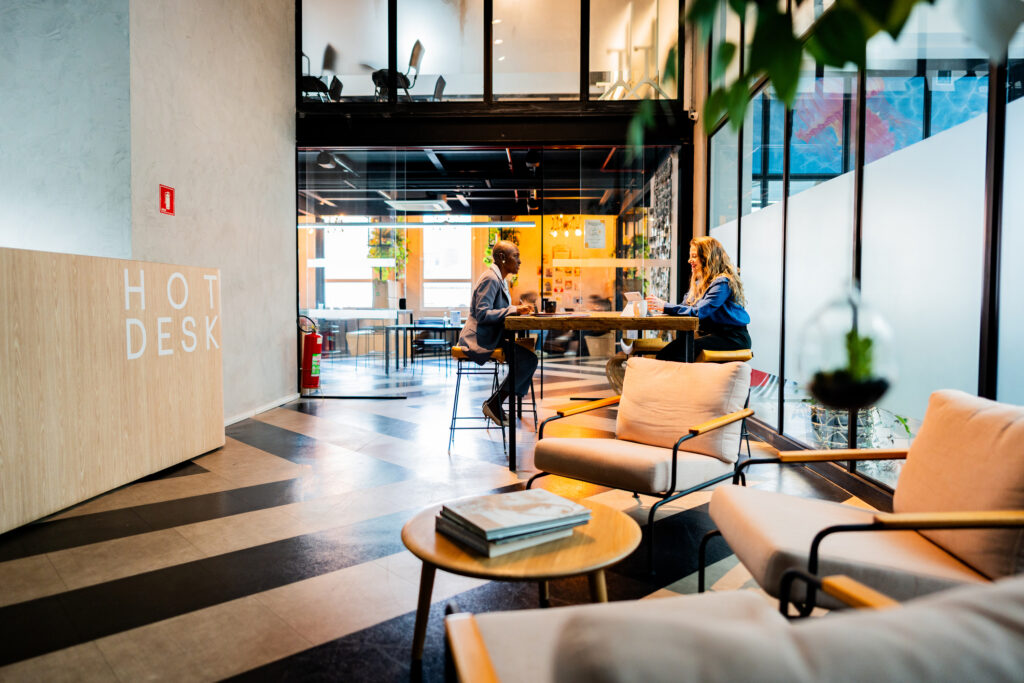What is a Coworking Space and How does it Work?
What is a coworking space? It’s a shared workspace where people from different companies work alongside each other, rather than being stuck in a traditional office environment with the same colleagues every day.
The coworking movement started gaining traction in major cities about two decades ago. Now you’ll find these spaces in smaller cities too, serving remote workers who need somewhere professional to meet clients, small businesses that can’t afford their own office lease, and creative freelancers tired of working from coffee shops.
These spaces work differently from renting a desk in standard office buildings. Coworking memberships vary widely, and you can select from pay by the day, month, or year. The same is true for the workplace dynamic, a marketing company might be close to a tech startup. This mixing of professions encourages interactions among different professionals that might not occur in a traditional office.
The concept appeals to professionals for practical reasons. Many remote workers struggle with isolation when working from home. Small business owners need meeting spaces to impress clients but can’t justify the expense of a private office. Creative freelancers want access to professional equipment like high-quality printers and reliable internet without the overhead costs.
Coworking spaces address these needs while offering something traditional offices often lack: the energy that comes from working around motivated professionals pursuing different projects. Members frequently report that casual conversations lead to new business opportunities or creative insights they wouldn’t have gained working alone.
The Evolution: From Coffee Shops to Collaborative Hubs

Before coworking spaces existed, freelancers and remote workers made do with whatever they could find. Coffee shops became unofficial offices, with laptops crowding small tables and people nursing single drinks for hours. Libraries offered quiet spaces but came with strict rules about phone calls and conversations. Working from a home office seemed ideal until the isolation set in, or family interruptions made concentration nearly impossible.
The first official coworking space opened in San Francisco in 2005, created by software engineer Brad Neuberg. He called it “9 to 5” and set up shop in a feminist collective space in the Mission District. Neuberg wanted the structure of a traditional office without the corporate politics. His experiment attracted other freelancers who craved both independence and community.
The coworking model that emerged differed significantly from existing options. Unlike renting space in office buildings, which required long-term leases and significant upfront costs, coworking offered month-to-month flexibility. Members could access professional meeting rooms when needed but weren’t stuck paying for unused space.
It also solved problems that coffee shops and home offices couldn’t address. Coffee shops had unreliable internet, limited seating, and weren’t designed for phone calls or client meetings. A home office provided privacy but lacked the energy and networking opportunities that come from working around other professionals. The coworking model combined the best aspects of both while eliminating most drawbacks.
Early adopters were typically tech workers and creative professionals who understood the value of flexible work arrangements. As the concept proved successful, it spread to other cities and attracted a broader range of users – creating what coworking spaces are today.
Defining Coworking Spaces

The definition of a coworking space is straightforward: it is a shared workspace where professionals from various companies work together in the same environment. They provide the infrastructure of a traditional office without requiring long-term commitments or the expense of setting up your own space. Most offer desks, meeting rooms, high-speed internet, and basic office amenities like printers and coffee.
What they offer goes beyond just physical space. Members get access to a professional environment where they can take client calls, hold meetings, and work alongside other motivated professionals. The setup allows small teams to expand or contract their workspace needs without renegotiating leases or buying additional furniture.
The mix of coworking participants creates an interesting dynamic. A freelance graphic designer might sit next to a three-person tech startup, while a remote employee from a large company works at the next table. Some spaces also attract small teams from international enterprises who need local workspace for traveling employees or temporary projects.
This diversity means the person working beside you could be developing a mobile app, writing marketing copy, or analyzing data for a Fortune 500 company. The variety keeps the environment energetic and opens up possibilities for unexpected collaborations.
Different companies benefit from this arrangement in various ways. Solo freelancers gain access to professional meeting spaces they couldn’t afford independently. Small teams can scale their workspace up or down based on current needs. Even large companies use coworking spaces to house remote workers or test new markets without committing to permanent office space.
The model works because it distributes costs across multiple users while giving everyone access to amenities they might not otherwise afford.
Core Features of a Coworking Space

Most coworking spaces include essential amenities that make professional work possible. High speed internet is standard, along with access to printers, scanners, and other office equipment. Meeting rooms can be booked for client presentations or team discussions. Many locations also provide reception services, handling mail delivery and greeting visitors professionally.
Workspace options vary depending on what members need. A hot desk gives you access to any available workspace on a first-come, first-served basis. This works well for people who don’t need the same spot every day or prefer variety in their surroundings. A dedicated desk means you have the same workspace reserved specifically for you, where you can leave personal items and set up your workspace exactly how you like it.
For those requiring more privacy, many spaces offer private office options. These might be individual offices for solo professionals or small rooms that can accommodate a team of three to five people. Private rooms provide quiet spaces for phone calls, confidential work, or simply getting away from the buzz of the main workspace.
The layout typically balances open areas with private options. Open spaces encourage interaction and create an energetic atmosphere, while private rooms serve members who need quiet concentration or confidential conversations.
Access terms reflect the flexible nature of these spaces. Some people pay hourly rates for occasional use, while others prefer daily passes when they need workspace for short projects. Monthly memberships appeal to regular users who want consistent access without the commitment of a traditional lease. This flexible access makes coworking spaces practical for various work schedules and business needs.
Benefits of a Coworking Space Over a Traditional Office

The financial advantages of coworking spaces become clear when you compare them to traditional office leases. Most commercial leases require multi-year commitments, substantial security deposits, and personal guarantees that can put business owners at financial risk. Coworking memberships eliminate these concerns since there’s no long term lease involved. Members can adjust their workspace needs month by month without penalty.
Cost savings extend beyond just rent. Traditional offices require significant upfront investment in furniture, equipment, and setup costs. You’ll need desks, chairs, filing cabinets, a phone system, internet installation, and countless other items before anyone can start working. Coworking spaces provide all the amenities of a professional environment from day one.
Utility bills, maintenance, cleaning services, and equipment repairs become someone else’s responsibility. These operational costs can add thousands of dollars monthly to a traditional office, but they’re already included in coworking membership fees. The predictable monthly cost makes budgeting easier for small businesses and small teams.
The scalability factor particularly benefits growing operations. A startup might begin with one desk and expand to a private office as they hire employees. Traditional office space doesn’t offer this flexibility. You either commit to more space than you need or risk outgrowing your lease before it expires.
For established businesses, coworking spaces provide options for temporary expansion, seasonal workers, or testing new markets. A company can set up workspace in a new city without signing a lease or investing in furnishing an entire office. This flexibility allows businesses to respond quickly to opportunities without being locked into fixed overhead costs.
More Than Just a Space: Building Community

Most coworking spaces employ community managers who focus on creating connections between members. These aren’t just administrative staff who handle bookings and collect payments. They actively introduce members to each other, organize group activities, and help foster a collaborative workspace atmosphere. A good community manager might notice that two members are working on complementary projects and make an introduction.
The physical layout supports these connections. Open lounges provide casual meeting spots where conversations happen naturally. Shared kitchens become gathering places during coffee breaks and lunch hours. Some spaces include digital hubs with large screens where members can share presentations or collaborate on projects. These common areas are designed to encourage interaction rather than isolate people at their desks.
Networking events range from casual happy hours to structured presentations where members can showcase their work. Some spaces host lunch-and-learn sessions where an expert member teaches others about their specialty. These events help members exchange ideas without the pressure of formal business meetings.
The community aspect allows professionals to share ideas in ways that wouldn’t happen in a traditional office. A marketing consultant might overhear a conversation about web development and offer insights that help solve a problem. A freelance writer could collaborate with a graphic designer on a project that benefits both of their clients.
Working alongside others from different industries can also influence company culture in positive ways. Solo entrepreneurs often struggle with isolation and lack of feedback. Being around other motivated professionals provides energy and perspective that’s hard to replicate when working alone. Small teams benefit from observing how other businesses operate and solve problems.
This community element distinguishes coworking spaces from simple office rentals. Members aren’t just paying for a desk and internet access. They’re joining a professional network that can lead to partnerships, referrals, and business opportunities.
This structure of collaborative ecosystem is what makes a coworking space work.
Who Uses Coworking Spaces?

Solo professionals make up a significant portion of coworking members. Creative professions like graphic designers, writers, photographers, and consultants often choose coworking spaces over home offices. These professionals need quiet environments for focused work but also benefit from being around other people during the day. Remote workers employed by companies in other cities use coworking spaces to maintain work-life boundaries and access professional meeting facilities when needed.
Freelancers across various industries find coworking spaces particularly valuable. A freelance accountant might need a professional setting to meet with clients during tax season. A web developer could benefit from the reliable internet and backup power systems that home offices often lack. These solo professionals appreciate having access to amenities like printers, scanners, and conference rooms without the expense of maintaining their own office.
Business clients range from early-stage ventures to established corporations. Tech startups often begin in coworking spaces because they need flexibility as their teams grow. A three-person software company might start with hot desks and eventually move to a private office within the same building. This allows them to scale their workspace costs with their revenue.
Different companies use coworking spaces for various strategic reasons. A consulting firm might rent workspace in multiple cities to serve clients locally. A manufacturing company could house their sales team in a coworking space closer to key customers. International enterprises sometimes use coworking spaces for employees who travel frequently or work in markets where they don’t have permanent offices.
Teams needing professional workspaces without geographic constraints find coworking particularly useful. A marketing agency might have team members scattered across different neighborhoods who meet at a central coworking location. Remote teams visiting from other cities can rent workspace together for intensive project work or planning sessions.
The diversity of users creates an environment where different business perspectives mix naturally, often leading to unexpected collaborations and learning opportunities.
Coworking Spaces Worldwide

Coworking spaces established themselves first in major cities where freelancers and startups were already concentrated. San Francisco led the way, followed quickly by other tech hubs like New York and London. Tokyo embraced the concept as remote work became more accepted in Japanese business culture. These cities offered the right combination of high real estate costs, dense populations of independent professionals, and entrepreneurial energy that made coworking financially viable.
The expansion into smaller cities happened gradually as the model proved successful. Mid-sized cities like Austin, Portland, and Manchester began attracting coworking operators who recognized untapped demand. Remote workers in these locations faced the same challenges as their counterparts in major metropolitan areas but had fewer workspace options. Local entrepreneurs saw opportunities to serve these underserved markets.
Today, coworking spaces operate across every continent. Cities that wouldn’t have supported traditional executive suites now host thriving coworking communities. The spread reflects changing work patterns rather than just urban trends. As companies embrace remote work policies, employees need professional workspace options regardless of their location.
Servcorp exemplifies how coworking providers have built international networks. Operating as a coworking provider in more than 40 cities across Asia, Australia, Europe, and the Americas, they offer members access to workspace wherever their business takes them. A consultant based in Sydney can book meeting rooms in Singapore or work from a Servcorp location in London without arranging separate memberships.
This global expansion has created opportunities for businesses to operate more flexibly. A startup can test new markets by establishing workspace in different cities without committing to permanent offices. Established companies can support remote employees or traveling teams by providing access to professional workspace anywhere their people need to work.
The worldwide growth demonstrates that coworking addresses universal workplace needs rather than just urban trends in specific markets.
Coworking Membership Options

Coworking membership tiers accommodate different usage patterns and budgets. Hourly rates work well for people who need occasional access to professional workspace or meeting rooms. A freelancer might pay hourly rates when meeting clients or when their home office becomes too distracting. Daily passes appeal to consultants or remote workers who need workspace for specific projects or when traveling to different cities.
Monthly memberships offer the best value for regular users. These typically include a set number of hours or days per month, with options to purchase additional time when needed. Some spaces offer unlimited monthly access, which suits professionals who treat the coworking space as their primary office.
The workspace type affects both cost and experience. A hot desk membership gives you access to any available workspace in common areas. You might sit in different spots each day, which some people prefer for variety. However, you can’t leave personal items overnight and need to pack up completely when you leave.
A dedicated desk means you have the same workspace reserved specifically for you. You can leave personal items, set up your monitor exactly how you prefer, and customize your space. This option costs more than hot desking but provides consistency and personalization that many professionals value.
Private office options range from individual offices to small rooms that accommodate teams. These provide quiet spaces for phone calls, confidential work, or simply getting away from the energy of shared areas. Private offices typically include storage space and allow members to conduct meetings without reserving separate conference rooms.
All membership levels include internet access, which is typically faster and more reliable than home connections. Members also benefit from flexible access hours, with many spaces offering 24/7 entry to accommodate different work schedules. Additional services like mail handling, printing allowances, and guest access can often be added to any membership tier.
Why the Best Coworking Space Is About Fit

The ideal coworking space depends entirely on what you need to accomplish. Culture varies significantly between locations. Some spaces cultivate a quiet, library-like atmosphere that suits people who need deep focus. Others encourage conversation and collaboration, creating buzzing environments where networking happens naturally. A graphic designer working on detailed projects might prefer the former, while a business development consultant could thrive in the latter.
Design affects how you work and feel throughout the day. Open layouts with high ceilings and natural light energize some people, while others find them distracting. Some spaces emphasize sleek, modern aesthetics, while others feel more like comfortable living rooms. The physical environment should match your work style and personal preferences.
Location matters for practical reasons. A space near your home reduces commute time, but one closer to your clients might be more valuable for your business. Access to public transportation, parking availability, and nearby restaurants all influence your daily experience. Consider how often you’ll need to travel from the space to meetings or other obligations.
Your primary goals should guide your decision. If you mainly need quiet focus time, prioritize spaces with private areas and enforced quiet zones. For networking opportunities, look for locations with active community programming and social spaces. If you frequently meet clients, choose spaces with professional meeting rooms and impressive common areas.
The best coworking space for you might disappoint someone else entirely. A startup founder building a team needs different things than a freelance writer working alone. A consultant who travels frequently has different requirements than someone who works from the same location daily.
Visit potential spaces during the hours you’d typically work. Notice the energy level, noise patterns, and types of people working there. Most spaces offer day passes or trial periods that let you experience the environment before committing to membership.
Rethinking Where Work Happens
Coworking has moved beyond trend status to become a permanent fixture in how businesses operate. The pandemic accelerated remote work adoption, but the underlying factors that make coworking valuable existed long before 2020. Rising real estate costs, changing employee expectations, and the growth of freelance and contract work have created lasting demand for flexible workspace solutions.
The coworking environment addresses fundamental workplace needs that traditional offices often miss. A founder building a startup benefits from the energy and networking opportunities that come from working alongside other entrepreneurs. Freelancers gain access to professional amenities and social interaction that home offices can’t provide. Even large enterprises use coworking spaces to house remote teams, test new markets, or provide flexible options for employees who don’t need assigned desks.
The scalability factor makes coworking particularly valuable as businesses adapt to changing conditions. A company can expand or contract its space needs without renegotiating leases or dealing with furniture logistics. This flexibility has become essential as businesses face unpredictable growth patterns and evolving work preferences.
What started as an alternative to coffee shops and home offices has evolved into a comprehensive workplace solution. The supportive community aspects help combat the isolation that remote work can create. The professional amenities provide credibility and functionality that many independent professionals couldn’t afford on their own. The inspiring space design often motivates productivity in ways that traditional corporate environments struggle to match.
As work continues to evolve, coworking spaces will likely adapt further to meet new needs. The core concept of shared, flexible, community-oriented workspace has proven resilient across economic cycles and technological changes. For many professionals, the question isn’t whether to use coworking spaces, but which one fits their specific needs and goals.
In the end, understanding what a coworking space is helps professionals choose smarter work environments.





